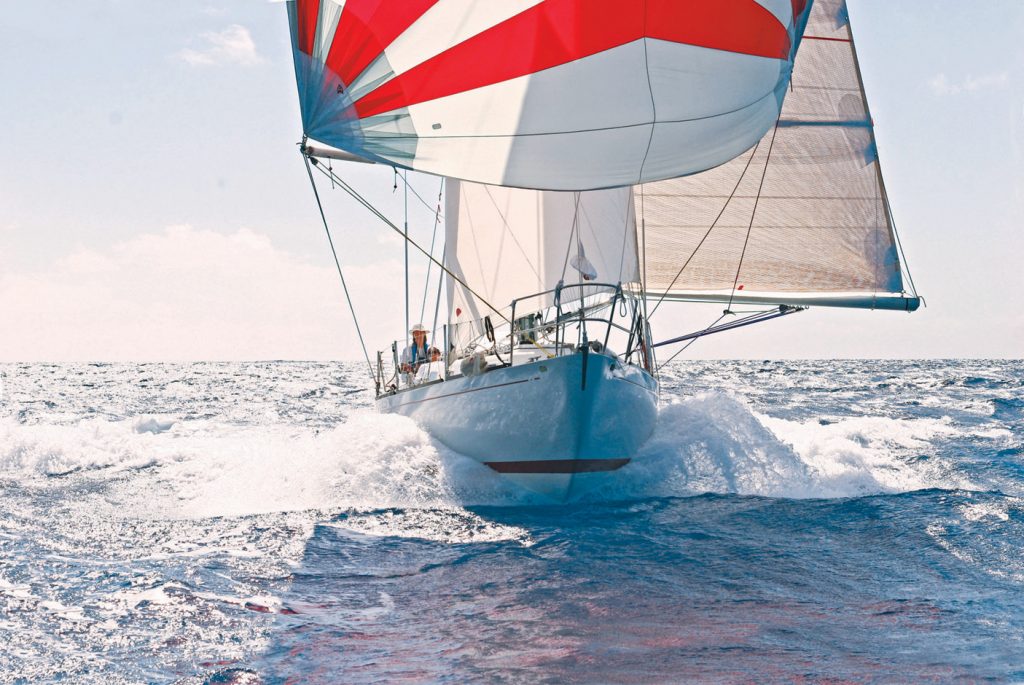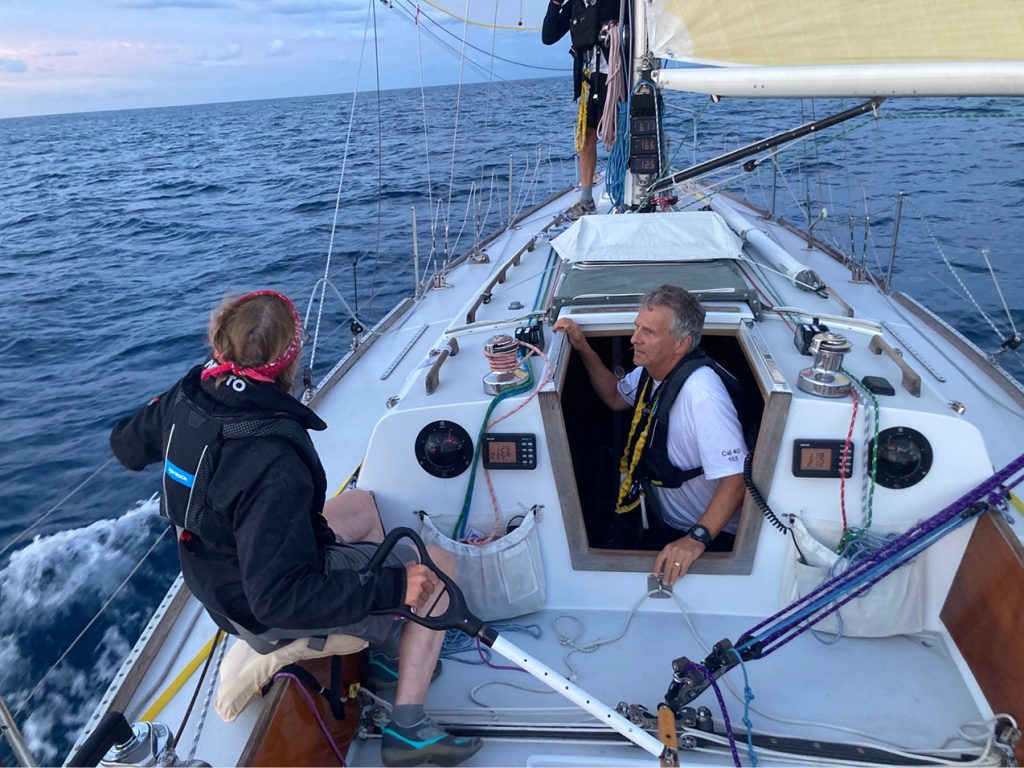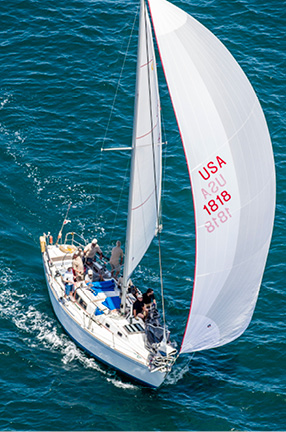
The “New” Illusion finishes the Transpac. Displacing just 15,000 pounds (unheard of for a 40-footer designed six decades ago), the Cal 40 can surf downwind at more than twice hull speed. Courtesy of Sally & Stan Honey
There are always boats that have stuck in our mind; some for their size and speed, some just for the impression that they made on you the sailor at a time in your boating life. Some of those boats have had an enviable and remarkable lifespan. For me, one of those boats was Illusion, the Cal 40 from Larchmont, pitch black. The black Cal 40, a Left Coast design that transported to the East in overnight and distance racing and became the gold standard of its time.
The Cal 40 was born in a Southern California boatyard off the drawing board of one William Lapworth. His inspiration for the canoe-shaped hulls and modest rigs contrasted with the “East Coast Style” of long ends and deep keels that had derived from designers from Herreshoff to Stephens. The Cal 40 design set the pace from its introduction in 1963. Cal 40, you are a senior classic, six decades young.
There exists a whole fraternity of West Coast designers. Nicholas Potter was best known for the California 32, the analogue to Olin Stephens’ NY 32. Gary Mull, Bob Perry, Bruce King – they all developed in the West Coast style expressed in fast cruising boats from Cal, Ranger and Ericson. But no boat made its mark like the Cal 40. The elite sailed them: Turner, Conner, Mosbacher. And in 2022, in the hands of perhaps the most seasoned of crews, Stan Honey and his sailing partner Sally Honey, the Cal 40 won the big one, the Thrash to the Onion Patch, the Newport Bermuda Race.
I have never set foot on a Cal 40. But my Princeton sailing colleague, Marilee Allan , from the Allan family of Olympians and long-distance sailors, talked about her family’s classic Herreshoff woodie. She recalled that the family Cal, Holiday Too, was skippered to Hawaii by her big brother Skip Allan, all of 22, with brother Scott in the late 1960s.
Cal 40: The Spade Rudder Rocket: Transpac to Newport Bermuda
But let’s review. What were the vital statistics of the Cal 40 and what was behind the radical nature of its design? The creation story is that in 1963 George Griffith, a member of the Los Angeles Yacht Club, sketched the design on the back of a napkin and showed it to Bill Lapworth who designed the boat.
According to its Wikipedia page, the Cal 40 was offered to several builders who turned it down. That left Griffith to back the building of the first ten boats, which in turn convinced the local Jensen Marine to start production. One hundred and eight were built from 1963 to 1971.
Conceived as an “offshore racer,” the Cal 40 was 39.33 feet long and 30.33 feet on the waterline, with a beam of 11 feet and draft of 5 feet 7 inches. At 15,000 pounds with 6,000 pounds of ballast she was incredibly light for the time, with a canoe-shaped hull that surfed downwind like a banshee. With a mainsail of 350 square feet and an original 170 percent LP overlap genoa, her sail plan in the golden age of overlap was hefty, in the range of 900 square feet with that big genoa.
Out of the blocks, the Cal 40s stunned its offshore competition. They started out winning the 1964 SORC and they kept winning for a generation. Peter Rebovich’s Sinn Fein, #1818 from Raritan, New Jersey, won the St. David’s Lighthouse Trophy in the 2006 and 2008 Newport Bermuda Races.
The Larchmont Connection: Illusion
My own link to the history of the Cal 40 was about a black boat with a black bottom. Cal 40 #57, Illusion, Larchmont Yacht Club. And my guide for that history is Bizzy Monte-Sano, two-time America’s Cup crew, ardent frostbiter, all-around sailor. It was his father, Vincent, who partnered with Emil “Bus” Mosbacher in 1965 to acquire the boat that succeeded Weatherly, the 1962 America’s Cup Defender, as the favorite boat for Mosbacher.
Bizzy in a winding and entertaining recollection of Illusion in the mid-1960s, said it was hard to remember all the details. He was busy… After all, Bizzy had been Lightning Atlantic Coast Champion in 1958 in an era when The New York Times covered yachting. After graduating Yale in 1963, he had sandwiched frostbiting winters at Larchmont with crew stints on Weatherly in 1962 and then again on Intrepid in 1967. He hadn’t done much racing on his father’s boat, but he did recall some crucial details about Illusion.
First, Illusion’s sail number was 1700. That was a nod to the #17 on the main of Weatherly, a Phil Rhodes design of 1958 that was extensively modified for the 1962 campaign against the Australian Gretel. All black with a white boot stripe, Illusion had no bottom paint, to go faster, so long as the bottom was cleaned.

Sally & Stan Honey on their way to the overall win in the 2022 Newport Bermuda
As Bizzy recalled, Illusion was the first of three well-known Cal 40s that appeared on Long Island Sound sometime after 1965. One was Thunderbird, sail #1473 owned by the chief executive of IBM, Vincent Learson, who went on to do Bermuda Races with a bigger boat, Nepenthe. Another Cal 40 was campaigned by a Greenwich sailing family, the Lovelaces.
There was also a new look in sails with #1700, from a San Diego sailmaker.
“Dad was very good friends with Colin Ratsey and had used his sails,” Bizzy recalled, “but Illusion’s sails were North. No one had really seen them out here, but Bus knew that most of the Cal 40s were in California and they used North.”
Between 1965 and ‘67, Illusion had an enviable race record from Long Island Sound to Southern New England. Many of the highlights came in New York Yacht Club events like the win in the Astor Cup. Illusion was generally one of the smaller boats in the fleet, but she had Bus Mosbacher, the matinee idol of American skippers, at the helm. The campaign ended in 1967 when Mosbacher, citing other pressing commitments, sold his share back to Vincent Monte-Sano. Bizzy remembers the boat being around for another year or so, but at a point everyone moved on.
Stan and Sally’s Wonderful Adventure with Illusion
Jump forward more than twenty years. A renowned electronics guru and a talented sailmaker were looking for a boat for both long distance racing and shorthanded cruising. Reenter Illusion, appearing again in 1988 in the hands of the team Stan and Sally Honey, who had searched high and low for a Cal 40 to redo.
Sally Honey, who made many of the downwind sails for Honey family boats, elaborated on the Cal 40’s power and boathandling ease.
“Now with the same mainsail size, but a 155% max genoa, her upwind sail area is just over 900 square feet,” said Sally. “She is very well balanced with that combination, and easy to steer through waves upwind.
She went on to explain how Illusion mastered the Mixmaster chop at the start of the 2022 Newport Bermuda Race. “Carl Buchan took all of five minutes to nail the technique when we first sailed with him on a practice race outside the Golden Gate in the Lightship Race. This is one of the reasons I asked him to start the Newport Bermuda Race, even though I am usually the driver. He had just won the Master Mariner Regatta and I was rusty after eight years of cruising.”
And what makes the Cal 40 steer so well off the wind? The boat had an internally mounted spade-type rudder – four years before such an appendage appeared with Intrepid in the America’s Cup. The combination of flat-bottomed hull and rudder allowed control in sustained wave surfing at high speed. Translation: Wicked fast downwind in a breeze. The hull speed was 7.38 knots.
In the waves downwind they went a lot faster. Straight down Long Island Sound in an easterly, on the back side of Block Island or headed for Hawaii, these boats flew at speeds two times hull speed and more.
There is no surprise that the Cal 40 is considered “one of the most influential designs and successful racing boats ever” (Sailboatdata.com). No wonder Cal 40s owners are a cult. Again from Wikipedia, Tom Burden wrote, “Today, the Cal 40 has attained true ‘cult’ status as a design that is sought after, restored, and passed down through multiple generation of families. Try searching for Cal 40s that are for sale in Yachtworld and other sites and you’ll likely come up empty. Folks spend multiple years and a quarter million dollars restoring Cal 40s and fitting them out with the latest sails gear and electronics…The Cal 40 has endured because it is not only a relatively quick downwind raceboat, but also a sweet sailing light cruiser.”
A Winning Ride to Bermuda
Sally & Stan Honey won the 2022 Newport Bermuda Race with a crew of friends, albeit rock star friends. Photos of Illusion surfing in what were for many very rough conditions are epic.
“The conditions we experienced, although rough for some, were perfect for a Cal 40,” said Sally. “We never tacked, jibed three times, and were pretty much fast reaching the whole race. With five good drivers, it was an ideal trip. Our watch system allowed us to stay focused. Stan floated as the all-important navigator (he chose the perfect course through the Gulf Stream and beyond). The rest of us took staggered four-hour watches, with two people changing every two hours and everyone up for every sail change and jibe.”
The transition from sailing a trapeze speedster to a 40-foot sled had always been natural, Sally reflected. “When Stan and I bought Illusion, we had been racing 5O5s together for multiple decades. So, she seemed like a dinghy with training wheels to me – no capsizes. Even the few times we rounded up, she just settled back down after a minute or two and we carried on. What a treat.”
Even though we only sailed her a couple of times before our first double-handed Pacific Cup and I had never sailed with an autopilot, it only took a day and a night to figure out that she was pretty much headed to Hawaii on her own. During our second Pacific Cup in 1996, we were able to push her really hard, jibing about fifteen times the second night to stay on Stan’s desired course. We won overall against all the fully crewed boats. Nice.”[The Pacific Cup starts in San Francisco and finishes in Kaneohe on the east side of Oahu.]
Twenty-four years later, the Honeys fixed their attention on the Bermuda Race. After years of cruising, they refitted and sailed the boat on its own bottom through the Panama Canal to be ready for June 2020. We all know how that season transpired, and the boat stayed east in Maine. And the crew returned for the 2022 race.
Sally Lindsay shared with me the roster of Bermuda 2022.
“Our crew for the 2022 NBR was Carl Buchan, Don Jesberg and Jonathan Livingston, all friends we had sailed against in either 5O5s or Cal 40s,” said Sally. “They all signed up instantly for the 2020 race and again for 2022. We were delighted.”

Peter Rebovich’s Sinn Fein won the St. David’s Lighthouse Division in the 2006 and 2008 Newport Bermuda Races. © Daniel Forster/PPL
Illusion Comes Back to Life
The story of how Illusion came back to life in 1988 demands retelling. Both Stan and Sally would qualify as serial boating entrepreneurs. Sally is known for her wizardry with marine canvas. Earlier in her career, she came from the world of sailmaking with North in Stratford, Connecticut. For sure, it is useful to have a sailmaker in your household.
Stan describes himself as a “professional navigator,” on board for ‘round the world races with Mike Sanderson, on Larry Ellison’s race boat, among others. Stan’s first talent is as an entrepreneur with visual data, where he pioneered a string of innovations in displaying on-screen information. Larry Ellison commissioned Stan to produce the 2013 America’s Cup cat tracker that allowed us all to figure out who was ahead with the mega catamarans dueling off the Citifront. Stan had produced the “yellow line” outlining the football field that you see in an NFL game broadcast. And amid all that, he created visual data technology for Rupert Murdoch’s News Corp. Polymath, navigator, Silicon Valley techie – I would call him a maritime Edison, with a dazzling engineering bag of tricks.
Bullet Holes to Nailing the Gulf Stream
The story of the “new” Illusion has a bizarre and unusual element. The Honeys bought the boat in poor condition, from a seller who went to great lengths to be anonymous.
Outside Santa Cruz, California they found in a shrouded elephant’s graveyard of a boatyard, a barely recognizable Cal 40. Not sailable, belonging to someone but a someone who did not wish to be revealed. The hull was not totally attached to the deck. There were bullet holes in the hull. “OK,” Stan and Sally said, “we’ll play along with this.” Sorting out the ownership and title was like solving a murder mystery.
Then the work began. A lot of work. When water was poured on the deck, it came down in sheets in the interior. The hull was intact (except for the bullet holes), it seemed like not much else was. From there it was the usual sailboat renovation story. Acquired in 1988, “New” Illusion was not a one-year project. By 1990, they had a workable boat to try and enter “the other Transpac.”
Thirty-two years later, they sailed a dream race from Newport to Bermuda. It was a chaotic start in June 2022, with a front ripping through mid-starting sequence. How did Navigator Stan call the race? Exactly right. In and out of the Gulf Stream, just right. No tacks, three jibes, only one blown kite, and a convincing win overall. No wonder Stan Honey is Navigator to the Stars.
When I asked Illusion’s Navigator if he ever sleeps during a race, he just chuckled. The Navigator just naps. He’s used to it. He has done it a long, long time. Cal 40 to maxi, it makes no difference. The Navigator never sleeps. ■
Tom Darling is the host of Conversations with Classic Boats, “the podcast that talks to boats.” Tune in via Apple Podcast, Google Podcast or Spotify, or online at conversationswithclassicboats.com.




